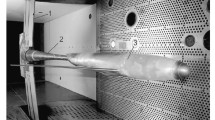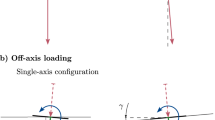Abstract
A one-component strain gauge dynamometer with a force measurement range of 0–0.33 N was developed and manufactured at the N. E. Zhukovsky Central Aerohydrodynamic Institute, to measure the unsteady friction force of the boundary layer on the wind tunnel walls at remarkably high Reynolds numbers. The static and dynamic characteristics of the dynamometer and its systematic errors were also investigated. The effects of the temperature, longitudinal, normal, and lateral forces, as well as the position of the longitudinal force application, were analyzed during the calibration. A block was designed and manufactured to calibrate the dynamometer using dead weights in a wind tunnel. Special experiments were performed in laboratory conditions to determine the friction force acting on the block axis. The developed dynamometer represents a dynamic system with its natural frequency of oscillations. The correction for the dynamics of the dynamometer is suggested on the basis of the method developed earlier. The mass of the metric part of the dynamometer, its natural oscillation frequency in the absence of damping in the direction of measuring the friction force, and the damping coefficient were determined to calculate the correction. The correction is verified by experiment with the application of a stepwise force. The effect of static and dynamic temperature components (the influence of the average temperature value and its change over time, respectively) on dynamometer readings was investigated. Corrections are proposed to eliminate the systematic errors due to the effect of temperature based on the previously developed method. Results revealed that the lateral force does not affect the dynamometer readings, while the effect of the normal force is 1.1% of the sensitivity coefficient of the longitudinal force. The temperature sensitivity of the sensitivity coefficient of the dynamometer is 0.017%/°C. The total measurement uncertainty of the friction force dynamometer was estimated as the standard deviation of the measurement results from the average value not exceeding 0.076% of the measurement range, and the relative uncertainty of the sensitivity coefficient is not more than 0.03%. The measurement uncertainty of the unsteady friction force will not exceed 0.86% of the dynamometer range with natural oscillations of the sensitive element. The developed single-component strain gauge dynamometer can be used to determine the friction coefficient of the boundary layer on a flat surface.






Similar content being viewed by others
References
V. I. Kornilov, Yu. A. Litvinenko, “Skin friction measurements in an incompressible turbulent boundary layer. Part 1. Adverse pressure gradient,” Thermophys. Aeromechanics, No. 4, 475–491 (2001).
J. M. Osterlund, Experimental Studies of Zero Pressure-Gradient Turbulent Boundary-Layer Flow, Doctoral dissertation of Technical Sciences, Royal Institute of Technology (1999).
V. N. Ozerov, “Determination of the local resistance friction coefficient from the results of measurements of the turbulent velocity profile at transonic speeds,” Uch. Zapiski TsAGI, 7, No. 2, 67–72 (1976).
A. I. Ivanov, A. D. Khon’kin, and G. K. Shapovalov, “Experimental study of the turbulent friction characteristics with transonic speeds,” J. Eng. Phys. Thermophys., 43, No. 1, 25–31 (1982).
S. Dhawan, “Direct measurements of skin friction,” NACA Report 1121, (1953), available at https://ntrs.nasa.gov/citations/19930092157 (accessed: 7/12/2023).
D. E. Coles, J. Fluid Mech., 1, 191–226 (1956). https://doi.org/10.1017/S0022112056000135.
R. J. Hakkinen, “Measurement of turbulent skin friction on a flat plate at transonic speeds,” NACA TN 3486, (1955), available at https://ntrs.nasa.gov/citations/19930084308 (accessed: 07/12/2023).
D. W. Smith, J. H. Walker, “Skin friction measurements in incompressible flow,” NASA TR R‑26, (1959), available at https://ntrs.nasa.gov/citations/19980227359 (accessed: 07/12/2023).
K. G. Winter, L. Gaudet, Turbulent Boundary-Layer Studies at High Reynolds Numbers at Mach Numbers between 0.2 and 2.8, Royal Aircraft Establishment RAE, (1973), available at https://repository.tudelft.nl/islandora/object/uuid%3A435c7823-4fe2-43a6-b29d-908a76531464 (accessed: 12/07/2023).
R. D. Watson, J. B. Anders, and R. M. Hall, “Skin friction at very high Reynolds numbers in the national transonic facility,” NASA/TP-2006-214497, (2006), available at https://ntrs.nasa.gov/citations/20060046371 (accessed: 07/12/2023).
W. J. Baars, D. T. Squire, K. M. Talluru, M. R. Abbassi, N. Hutchins, and I. Marusic, Exp. Fluids, 57, 90 (2016). https://doi.org/10.1007/s00348-016-2168-y.
M. A. Ferreira, E. Rodriguez-Lopez, and B. Ganapathisubramani, Exp. Fluids, 59, 155 (2018). https://doi.org/10.1007/s00348-018-2612-2.
A. Gorbushin, S. Osipova, and V. Zametaev, Flow Turbul. Combust, 107, 31–50 (2021). https://doi.org/10.1007/s10494-020-00232-z.
F. H. Clauser, “The turbulent boundary layer,” Adv. Appl. Mech., 4, 1–51 (1956). https://doi.org/10.1016/S0065-2156(08)70370‑3.
L. L. Chernyshev, V. D. Vermel, A. R. Gorbushin, K. F. Latsoev, A. O. Shardin, I. V. Rozin, D. S. Rudenko, and I. N. Kacharava, Patent RU 2780307 C1, Inventions. Utility models, No. 27 (2022).
V. V. Burov, V. S. Volobuev, S. A. Glazkov, A. R. Gorbushin, and E. K. Chumachenko, Autom. Remote Control, 72, 634–641 (2011). https://doi.org/10.1134/S0005117911030143.
H. Schlichting, Boundary Layer Theory, McGraw-Hill, New York, (1979).
A. R. Gorbushin, A. A. Bolshakova, Measurement, 152, 107381 (2020). https://doi.org/10.1016/j.measurement.2019.107381.
A. R. Gorbushin, Patent RU 2743778 C1, Inventions. Utility models, No. 6 (2021).
L. G. Loitsyaenskii, A. I. Lur’e, Course of Theoretical Mechanics, Nauka, Moscow (1983).
A. R. Gorbushin, TsAGI Sci. J., 40, No. 4, 485–495 (2009). https://doi.org/10.1615/TsAGISciJ.v40.i4.70.
B. F. R. Ewald, Meas. Sci. Technol., 11, No. 6, 81–94 (2000). https://doi.org/10.1088/0957-0233/11/6/201.
V. V. Bogdanov, A. R. Gorbushin, and V. S. Volobuyev, TsAGI Sci. J., 40, No. 5, 619–629 (2009). https://doi.org/10.1615/TsAGISciJ.v40.i5.80.
A. R. Gorbushin, E. A. Krapivina, and M. N. Tytyk, Meas. Tech., 64, No. 10, 794–800 (2022). https://doi.org/10.1007/s11018-022-02006-7.
Calibration and Use of Internal Strain-Gage Balances with Application to Wind Tunnel Testing, AIAA Rec. Practice, (2020), AIAA R‑091A-2020. https://doi.org/10.2514Z4.106019.001.
Funding
The study was performed at the Central Aerohydrodynamic Institute with the support of the Russian Science Foundation, grant No. 23-19-00041, https://rscf.ru/project/23-19-00041/. The literature review was performed at the Moscow Institute of Physics and Technology.
Author information
Authors and Affiliations
Corresponding author
Ethics declarations
Conflict of interest
The authors declare no conflict of interest.
Additional information
Translated from Izmeritel’naya Tekhnika, No. 7, pp. 41–48, July, 2023. Russian https://doi.org/10.32446/0368-1025it.2023-7-41-48
Publisher’s Note
Springer Nature remains neutral with regard to jurisdictional claims in published maps and institutional affiliations.
Original article submitted May 17, 2023. Original article reviewed June 26, 2023. Original article accepted June 27, 2023
Rights and permissions
Springer Nature or its licensor (e.g. a society or other partner) holds exclusive rights to this article under a publishing agreement with the author(s) or other rightsholder(s); author self-archiving of the accepted manuscript version of this article is solely governed by the terms of such publishing agreement and applicable law.
About this article
Cite this article
Anokhina, E.N., Gorbushin, A.R. Strain gauge dynamometer for measuring the boundary layer friction force on the walls of wind tunnels. Meas Tech 66, 498–507 (2023). https://doi.org/10.1007/s11018-023-02251-4
Published:
Issue Date:
DOI: https://doi.org/10.1007/s11018-023-02251-4




